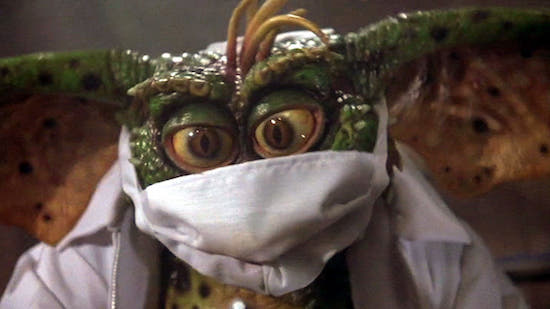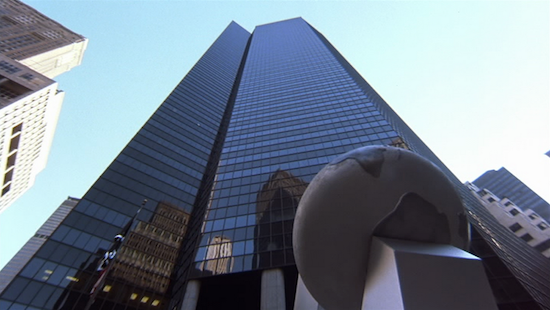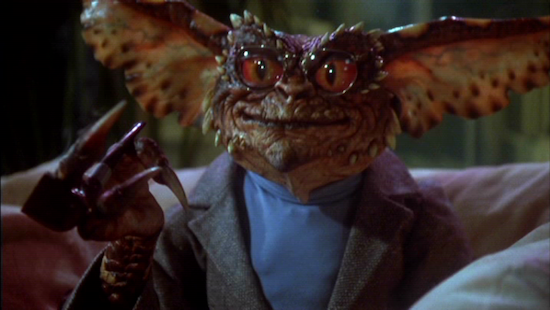“Western thought has a tendency to view the new as a restatement of the old, which can limit the potential of even the most revolutionary thought. The Gremlins are the appearance of the "absolutely new", they overcome the "abyss of spontaneity" that paralyses human action.” – @G2Institute
America’s most sophisticated “smart building” has gone haywire. There are gremlins in the system. A property developer-cum-media mogul is chewing up New York. Monsters with high tech weapons have designs on America’s most recognisable landmarks. Billionaires are rediscovering small town “traditional values”. The broadcast networks are preparing to announce the end of civilization.
No, these are not tomorrow’s headlines. This is Gremlins 2: The New Batch.
For too long curtly dismissed as a half-baked cash-in sequel to a low-rent cheesy horror fantasy, since December 2017, a small underfunded research institute in New York has been determinedly setting the record straight.
“Dada, punk, Gremlins 2 – many twentieth century movements understand that an art form can only achieve its full realization through a process of negation and destruction.” Welcome to the institute of Gremlins 2 Studies.
“While Heidegger’s project was radically anti-Platonic, ultimately his ideas about the authentic & his negative portrayal of publicness lead him to the same inward turn (or cowardly retreat) as Plato. To right this wrong I propose a new school of ‘Gremlin-Oriented Ontology’.” – @G2Institute
With its frozen yogurt and fully-networked work-leisure hybrid spaces, from the aspect of the present, Gremlins 2 can hardly fail to look prescient – not least because of the idiot-prince at its centre and his eponymous tower, so transparently based on a certain combed-over head of state.
But Gremlins 2 is equally compelling in its treatment of America’s past.
There are some topics that Hollywood can only approach through the lens of a whacky cartoonish fantasy. Just as Who Framed Roger Rabbit? remains one of the very few films to approach the conspiracy to destroy Los Angeles’s public transport infrastructure, so too Gremlins 2 is one of remarkably few films to tackle the destruction of lower Manhattan by real estate companies, the way developers were granted licence to gleefully tear through communities leaving only destruction in their wake.
“By the third act of Gremlins 2: The New Batch, the plot completely breaks down into cartoonish anarchy. The film achieves escape velocity: as Baudrillard writes in his essay ‘Pataphysics of the Year 2000’, it has ‘flown free of the referential sphere of the real and of history’.” – @G2Institute
For now, The Institute of Gremlins 2 may exist largely in the form of a Twitter account that may or may not be taking the piss. Tomorrow, perhaps, the world. I spoke to its anonymous author.
What prompted you to start this account?
What prompted me to found the prestigious Institute of Gremlins 2 Studies? That’s obvious. If you look around at the world today, you will probably feel like someone trapped in an over-the-top parody of past events. Only one film fully captures this feeling. Just look at how other accounts have attempted to imitate us using other films. Inevitably they all fail. Nobody holds a candle to the great work our Institute is doing. The reason for their failure is simple – only Gremlins 2 can be exhaustively returned to, combed over, analyzed in this way. What “genius” people may see in the Institute is only a reflection of the genius of Gremlins
Why Gremlins 2?
There are many reasons why Gremlins 2 remains relevant, even twenty-eght years after the film’s release. One important reason is the way the film adapts the cartoonish ethos of Looney Tunes, which allows it to treat reality with a certain playfulness and plasticity. In recent years this has become popular again – surreal humor and elaborate descriptions of cartoon violence are mainstays of internet humor, perhaps reflecting a media and political environment that has become unmoored from reality.
Gremlins 2 was aware of this connection (between mass media and unreality), which is why the film takes place in a skyscraper that houses the Clamp Cable Network studios. This is also reflected in the nature of the Gremlins themselves – the more they reproduce and multiply, the more absurd and novel the types of Gremlin must become.
The delirious, exaggerated atmosphere of the movie sequel has invaded every other aspect of our culture. The demand for ever-escalating novelty – in products, movies, television, news – can only end in one place. Gremlins 2: The New Batch is the inevitable terminus of this culture.

“All satire is blind to the forces liberated by decay, which is why total decay has absorbed the forces of satire." To understand this is to understand Gremlins 2 Studies.” – @G2Institute
Are you in academia yourself?
The Institute of Gremlins 2 Studies is doing more important work than any official academic institution. We have no use for the kind of academia that is increasingly unavailable and detached from public life. Twitter is a vile place but at least we’re bringing our work straight to the public, rather than locking it away behind paywalls.
Academia is important, but I suspect it produces a kind of paralysis that leads scholars towards hyper-specialization and voluntary irrelevance. Maybe this has to do with vanity – people want to appear respectable more than anything else. Or maybe the economic precarity that is experienced while pursuing advanced degrees and working non-tenured positions conditions people not to take risks.
Do you remember the circumstances of your first viewing of Gremlins 2?
No, I do not remember the first time I viewed Gremlins 2. I watch it practically every day now, as that is my job. Every scene and every line has been burned into my memory, to the extent that I have no conception of what my first impression may have been.
What is your position on the possibility of a Gremlins 3 – or a possible reboot?
At the end of Gremlins 2, the CEO character Daniel Clamp notices a drawing of Billy’s hometown (and setting of the original Gremlins), Kingston Falls. He comments that this is what people want, and waxes poetic about his plans for a corporate simulacra of the town called Clamp Corners. I think in that moment, Gremlins 2 predicted the very idea of a “reboot”. But more than that, in that moment it predicted the retreat from the high modernism of the twentieth century that results in glass-and-steel behemoths like Clamp Center. Instead, we get nostalgia for an authentic sense of place, often the very place that the forces of capital obliterated in the first place. The very forces that destroyed the local is now attempting to recreate it in a sterilized, corporate form.
The same could be said about reboots – people don’t want the over-the-top extravagance and subversion of Gremlins 2. They want to relive that feeling they first had when they watched the original Gremlins. But this desire will always be quixotic: we cannot go back. We cannot keep reliving childhood experiences to escape this long, slow cultural and ecological apocalypse.
I think that much of the resentment in ‘nerd culture’ is a sublimated reaction to the impossibility of this flight into the past. That is what Gremlins 3, if such a thing were to be made, must embrace. In the words of Walter Benjamin, “Don’t start from the good old things but the bad new ones.”

“Replication is everywhere in Gremlins 2. Not only do the Gremlins reproduce rapidly, but there is a scene where Gizmo is shoved in a xerox machine & mercilessly photocopied. Something monstrous emerges through this repetition, a commentary on the nature of sequels.” – @G2Institute
If, as you say, Gremlins 2 is a postmodern retelling of the story of the Paris Commune, who is its Blanqui?
The Brain Gremlin, of course. But this comparison only goes so far. The Gremlins do not have a clear leader, their politics are radically horizontal. The Brain Gremlin is just a figurehead, and the ideology he expresses is cryptic and incomplete. He is elevated to that position only because it allows him to subvert our human ideas about hierarchy and sovereignty. When he shoots the Propeller Hat Gremlin, that is the encapsulation of power. That is the hidden power that defines human ideas of sovereignty – the power to kill.
The Gremlins also manage to provoke a similar reaction at the finale of the film: Clamp charges into the tower with an armed SWAT team to wipe out the Gremlins. He arrives too late, but that’s besides the point.
Let me put it another way: in Serbia in the year 2000, a group of activists painted the face of then-president Slobodan Milošević on a barrel, and let people pay to get a stick to hit the barrel. If they had no money because of Milošević’s policies, they were allowed to hit it twice.
Of course, this provoked a reaction. The police showed up, leading to the absurd image of them ‘arresting’ the barrel and taking it away. The activists had created a lose-lose situation for the government, because they would appear weak if they did nothing, but also appeared ridiculous when they choose to intervene in a prank.
We can understand the Gremlins as committing to a similar strategy, but with much higher stakes. The Gremlins created a situation that revealed the true configuration of power, though it cost them their lives.
How can Gremlins 2 simultaneously represent the radically new and a culture of total sequelization?
There is opportunity in decay, as Adorno reminds up. I like to talk about this concept, ‘Joe Dante’s Inferno’. In the original Inferno, the only way out is to go all the way down. Only when the characters reach the very bottom does gravity switch, and suddenly they are going up again.
I think that is the way out of our current culture of endless sequelization. We cannot escape that fact, we have to go all the way with it: only then can we find the new.
The Institute of Gremlins 2 Studies is online


